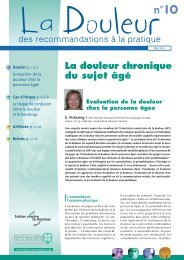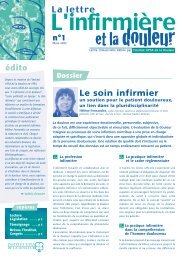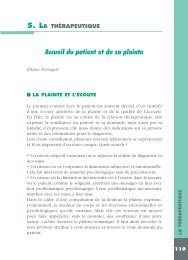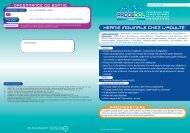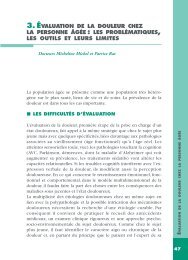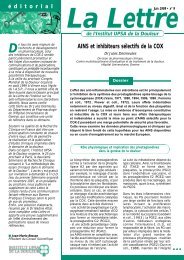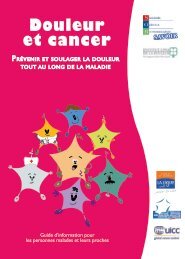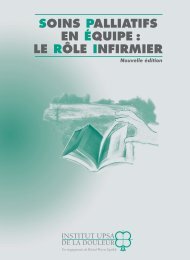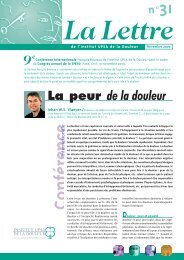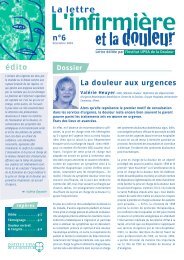Références1. Landi F, On<strong>de</strong>r G, Cesari M, et al. Pain management in frail, community-living el<strong>de</strong>rlypatients. Arch Int Med 2001; 161:2721-2724.2. Fe<strong>de</strong>rman AD, Litke A, Morrison RS. Association of age with analgesic use for back andjoint disor<strong>de</strong>rs in outpatient settings. Am J Geriatr Pharmacother 2006; 4: 306-315.3. Hwang U, Richardson LD, Sonuyi TO, Morrison RS. The effect of emergency<strong>de</strong>partment crowding on the management of pain in ol<strong>de</strong>r adults with hip fracture. JAmer Geriatr Soc 2006; 54: 270-275.4. Morrison RS, Siu AL. A comparison of pain and its treatment in advanced <strong>de</strong>mentia incognitively intact patients with hip fracture. J Pain Sympt Manag 2000; 19:240-248.5. Won A, Lapane K, Gambassi G, Bernabei R, Mor V, Lipsitz LA. Corre<strong>la</strong>tes and managementof nonmalignant pain in the nursing home. J Amer Geriatr Soc 1999; 47: 936-942.6. Boer<strong>la</strong>ge AA, van Dijk M, Stronks DL et al. Pain prevalence and characteristics in threeDutch resi<strong>de</strong>ntial homes. Eur J Pain 2008; 12: 910-916.7. Shi S, Mörike K, Klotz U. The clinical implications of ageing for rational drug therapy.Eur J Clin Pharmacol 2008; 64:183-199.8. Hammerlein A, Derendorf H, Lowenthal DT. Pharmacokinetic and pharmacodynamicchanges in the el<strong>de</strong>rly: Clinical implications. Clin Pharmacokin 1998; 35:49-64.9. Tumer N, Scarpace PJ, Lowenthal DT. Geriatric pharmacology: basic and clinicalconsi<strong>de</strong>rations. Annu Rev Pharmacol Toxicol 1992; 32: 271-302.10. Montamat SC, Cusack BJ, Vestal RE Management of drug therapy in the el<strong>de</strong>rly. N Engl JMed 1989; 321:303-309.11. Kinirons MT, Crome P. Clinical pharmacokinetics consi<strong>de</strong>rations in the el<strong>de</strong>rly: Anupdate, Clin Pharmacokin 1997; 33:302-312.12. Paolisso G, Gambar<strong>de</strong>l<strong>la</strong> A, Balbi V, Ammendo<strong>la</strong> S, D’Amore A, Varrichio M. Bodycomposition, body fat distribution, and resting metabolic rate in healthy centenarians.Amer J Clin Nut 1995; 62:746-750.13. Grandison MK, Boudinot FD. Age-re<strong>la</strong>ted changes in protein binding of drugs:implications for therapy, Clin Pharmacokin 2000; 38:271-290.14. Butler JM, Begg EJ. Free drug metabolic clearance in el<strong>de</strong>rly people. ClinPharmacokinet 2008; 47:297-321.15. Schmucker DL. Liver function and phase I drug metabolism in the el<strong>de</strong>rly: a paradox.Drugs Aging 2001; 18:837-851.16. Mallet L. Age-re<strong>la</strong>ted changes in renal function and clinical implications for drugtherapy. J Geriatr Drug Ther 1991; 5:5-29.SPÉCIFICITÉS DE LA PRISE EN CHARGE ANTALGIQUE DE LA <strong>DOULEUR</strong> CHEZ LA <strong>PERSONNE</strong> ÂGÉE105
SPÉCIFICITÉS DE LA PRISE EN CHARGE ANTALGIQUE DE LA <strong>DOULEUR</strong> CHEZ LA <strong>PERSONNE</strong> ÂGÉE17. Cockcroft DW, Gault MH. Prediction of creatinine clearance from serum creatinine.Nephron 1976; 16:31-41.18. No<strong>la</strong>n L, O’Malley K. Prescribing for the el<strong>de</strong>rly. Part I: Sensitivity of the el<strong>de</strong>rly toadverse drug reactions. J Amer Geriatr Soc 1988; 32:142-149.19. World Health Organization. WHO’s pain <strong>la</strong>d<strong>de</strong>r. Disponible à:www.who.int/cancer/palliative/pain<strong>la</strong>d<strong>de</strong>r/en/. Consulté le 7 décembre 2009.20. Ventafridda V, Tamburini M, Caraceni A, et al. A validation study of the WHO method forcancer pain relief. Cancer 1987; 59:850-856.21. Zech DF, Grond S, Lynch J, et al. Validation of the World Health Organization Gui<strong>de</strong>linesfor cancer pain relief: a 10-year prospective study. Pain 1995; 63:65-76.22. Eisenberg E, Marinangeli F, Birkhahn J, et al. Time to modify the WHO analgesic <strong>la</strong>d<strong>de</strong>r?Pain: Clinical Updates 2005; 3(5): 1-4.23. McNicol E, Strassels S, Goudas L, et al. Non-steroidal anti-inf<strong>la</strong>mmatory drugs, aloneor combined with opioids, for cancer pain: a systematic review. J Clin Oncol 2004;22:1975-1992.24. Marinangeli F, Ciccozzi A, Leonardis M, et al. Use of strong opioids in advanced cancerpain: a randomized trial. J Pain Sympt Manage 2004; 27:409-416.25. Lussier D, Portenoy RK. Adjuvant analgesics in pain management. In: Doyle D, Hanks G,Cherny N, et al., eds. Oxford Textbook of Palliative Medicine, Third Edition. Oxford,Eng<strong>la</strong>nd: Oxford University Press, 2003; 349-377.26. AGS Panel on Pharmacological Management of Persistent Pain in Ol<strong>de</strong>r Persons.Pharmacological management of persistent pain in ol<strong>de</strong>r persons. J Am Geriatr Soc2009; 57:1331–46.27. Ellmers SE, Parker LRC, Notarianni LJ, Jones RW. Excretion of paracetamol in fit andfrail el<strong>de</strong>rly people. J Am Geriatr Soc 1991; 39: 596-597 [abrégé].28. Gloth FM. Pain management in ol<strong>de</strong>r adults: prevention and treatment. J Amer GeriatrSoc 2001; 49:188-199.29. Likar R, Wittels M, Molnar M, Kager I, Ziervogel G, Sittl R. Pharmacokinetic andpharmacodynamic properties of tramadol IR and SR in el<strong>de</strong>rly patients: A prospective,age-group-controlled study. Clin Ther 2006; 28: 2022-2039.30. Beaulieu AD, Peloso PM, Haraoui B, et al. Once-daily, controlled-release tramadol andsustained-release diclofenac relieve chronic pain due to osteoarthritis: a randomizedcontrolled trial. Pain Res Manag 2008; 13:103-110.31. Pergolizzi J, Böger RH, Budd K, et al. Opioids and the management of chronic severepain in the el<strong>de</strong>rly: Consensus statement of an International Expert Panel with focuson the six clinically most often used World Health Organization step III opioids(buprenorphine, fentanyl, hydromorphone, methadone, morphine, oxycodone). PainPract 2008; 8:287-313.106
- Page 3:
DOULEUR ET PERSONNE ÂGÉEFrançois
- Page 6 and 7:
Docteur Micheline MichelService de
- Page 8:
6• La douleur en oncogériatrie -
- Page 11 and 12:
cessent d’augmenter avec l’âge
- Page 13 and 14:
onne marge de progression : que la
- Page 15 and 16:
primordial de savoir dépister la d
- Page 17 and 18:
du 29 mai 1997 sur « l’organisat
- Page 19 and 20:
partie aux objectifs du plan cancer
- Page 21 and 22:
◗ En 2008 : le plan de développe
- Page 23 and 24:
• Inciter l’établissement à s
- Page 25 and 26:
Références1. Propos empruntés à
- Page 27 and 28:
ÉPIDÉMIOLOGIE ET NEUROPHYSIOLOGIE
- Page 29 and 30:
ÉPIDÉMIOLOGIE ET NEUROPHYSIOLOGIE
- Page 31 and 32:
dents souffrant d’une forme ou d
- Page 33 and 34:
ÉPIDÉMIOLOGIE ET NEUROPHYSIOLOGIE
- Page 35 and 36:
ÉPIDÉMIOLOGIE ET NEUROPHYSIOLOGIE
- Page 37 and 38:
ÉPIDÉMIOLOGIE ET NEUROPHYSIOLOGIE
- Page 39 and 40:
En résumé• Les preuves issues d
- Page 41 and 42:
ÉPIDÉMIOLOGIE ET NEUROPHYSIOLOGIE
- Page 43 and 44:
ÉPIDÉMIOLOGIE ET NEUROPHYSIOLOGIE
- Page 45 and 46:
ÉPIDÉMIOLOGIE ET NEUROPHYSIOLOGIE
- Page 48 and 49:
3. ÉVALUATION DE LA DOULEUR CHEZLA
- Page 50 and 51:
pond le plus à l’expression de s
- Page 52 and 53:
spécialisée, consultation de rhum
- Page 54 and 55:
L’American Geriatric Society a ai
- Page 56 and 57: ECPA-2 (Échelle Comportementale po
- Page 58 and 59: lable les comportements du patient
- Page 60 and 61: Caractéristiquesrequises pourl’
- Page 62 and 63: Le recours systématique aux outils
- Page 64 and 65: Simple. Pour l’hétéro évaluati
- Page 66 and 67: Références1. American Geriatrics
- Page 68: 26. Rat P, Bonin-Guillaume S. Doule
- Page 71 and 72: DIMENSIONS PSYCHOLOGIQUES DE LA DOU
- Page 73 and 74: DIMENSIONS PSYCHOLOGIQUES DE LA DOU
- Page 75 and 76: DIMENSIONS PSYCHOLOGIQUES DE LA DOU
- Page 77 and 78: DIMENSIONS PSYCHOLOGIQUES DE LA DOU
- Page 79 and 80: En résumé• Les douleurs chroniq
- Page 81 and 82: DIMENSIONS PSYCHOLOGIQUES DE LA DOU
- Page 84 and 85: 5. SPÉCIFICITÉS DE LA PRISE EN CH
- Page 86 and 87: peuvent influencer l’absorption r
- Page 88 and 89: TRAITEMENT PHARMACOLOGIQUEDE LA DOU
- Page 90 and 91: toxicité hépatique se manifeste d
- Page 92 and 93: parentérale sont les mêmes que ch
- Page 94 and 95: • Fentanyl transdermique / L’ab
- Page 96 and 97: Bien que l’utilisation d’opioï
- Page 98 and 99: pour la douleur neuropathique, offr
- Page 100 and 101: Tableau 1: Doses de départ recomma
- Page 102 and 103: AnalgésiqueAntidépresseursEffets
- Page 104 and 105: PRISE EN CHARGE NON PHARMACOLOGIQUE
- Page 108 and 109: 32. Baillie SP, Bateman DN, Coates
- Page 110 and 111: 63. Wasan AD, Ossanna MJ, Raskin J,
- Page 112 and 113: 6. LA DOULEUR EN ONCOGÉRIATRIEDoct
- Page 114 and 115: de la mort. Des changements aussi p
- Page 116 and 117: Assez souvent, les symptômes sont
- Page 118 and 119: Les complications douloureuses post
- Page 120 and 121: toxicité plus fréquente chez les
- Page 122 and 123: prévention des douleurs liées aux
- Page 124 and 125: lors du diagnostic et des différen
- Page 126 and 127: et le déficit fonctionnel fait par
- Page 128 and 129: d’effets indésirables chez le su
- Page 130 and 131: procurent un effet antalgique immé
- Page 132 and 133: En résumé• Distinguer nocicepti
- Page 134 and 135: 7. DOULEURS OSTÉO-ARTICULAIRESDE L
- Page 136 and 137: polyarthrite chronique ; elle peut
- Page 138 and 139: ◗ Les pièges de la douleur osté
- Page 140 and 141: nécessaire de laisser un fond doul
- Page 142 and 143: suivante se fera alors 8 heures plu
- Page 144 and 145: La prise en charge physiqueChez cer
- Page 146 and 147: Références1. Agudelo CA, Wise CM.
- Page 148 and 149: 32. McCarberg BH. Rheumatic disease
- Page 150 and 151: 8. IMPACT DELADOULEUR NEUROPATHIQUE
- Page 152 and 153: L’ÂGE EST-IL UN FACTEUR DE RISQU
- Page 154 and 155: spécifiquement dans la douleur neu
- Page 156 and 157:
la douleur au niveau de la moelle
- Page 158 and 159:
Références1. Apkarian AV, Sosa Y,
- Page 160 and 161:
9. DOULEUR ET FIN DE VIEDocteur Ber
- Page 162 and 163:
proposer un traitement personnalis
- Page 164 and 165:
des comportements inadaptés des so
- Page 166 and 167:
malade, ce qui pose souvent problè
- Page 168 and 169:
◗ Oser remettre en question certa
- Page 170 and 171:
soignant (installation, matériel a
- Page 172 and 173:
Résumé• La prévalence de la do
- Page 174 and 175:
10. INTÉGRATION ET MÉMOIREDE LA D
- Page 176 and 177:
mais est-ce un effet de niveau cult
- Page 178 and 179:
seuils et la tolérance sont en rè
- Page 180 and 181:
proposé que la survenue de douleur
- Page 182 and 183:
INTÉGRATION ÉMOTIONNELLE DE LA DO
- Page 184 and 185:
sait que, chez le sujet âgé, il y
- Page 186 and 187:
Figure 4 : Niveaux de conscience et
- Page 188 and 189:
aucun souvenir de l’épisode et d
- Page 190 and 191:
la vieillesse ne peut s’analyser
- Page 192 and 193:
de la douleur plutôt que de l’an
- Page 194 and 195:
Références1. Bouhassira D, Lanter
- Page 196 and 197:
11. CONCLUSIONDocteur Gisèle Picke
- Page 198 and 199:
L’L’Institut UPSA de la Douleur
- Page 200:
279071004



